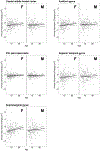Alcohol and cannabis co-use and longitudinal gray matter volumetric changes in early and late adolescence
- PMID: 36001427
- PMCID: PMC9413216
- DOI: 10.1111/adb.13208
Alcohol and cannabis co-use and longitudinal gray matter volumetric changes in early and late adolescence
Abstract
Background: Previous studies have characterized the impact of substance use on cerebral structure and function in adolescents. Yet, the great majority of prior studies employed a small sample, presented cross-sectional findings, and omitted potential sex differences.
Methods: Using data based on 724 adolescents (370 females) curated from the NCANDA study, we investigated how gray matter volumes (GMVs) decline longitudinally as a result of alcohol and cannabis use. The impacts of alcohol and cannabis co-use and how these vary across assigned sex at birth and age were examined. Brain imaging data comprised the GMVs of 34 regions of interest and the results were evaluated with a Bonferroni correction.
Results: Mixed-effects modeling showed faster volumetric declines in the caudal middle frontal cortex, fusiform, inferior frontal, superior temporal (STG), and supramarginal (SMG) gyri, at -0.046 to -0.138 cm3 /year in individuals with prior-year alcohol and cannabis co-use, but not those engaged in alcohol or cannabis use only. These findings cannot be explained by more severe alcohol use among co-users. Further, alcohol and cannabis co-use in early versus late adolescence predicted faster volumetric decline in the STG and SMG across assigned sex at birth.
Conclusions: Findings highlight the longitudinal impact of alcohol and cannabis co-use on brain development, especially among youth reporting early adolescent onset of use. The volumetric decline was noted in cortical regions in support of attention, memory, executive control, and social cognition, suggesting the pervasive effect of alcohol and cannabis co-use on brain development.
Keywords: National Consortium on Alcohol and Neurodevelopment in Adolescence (NCANDA); adolescence; alcohol and cannabis co-use; brain development; gray matter volume (GMV); longitudinal.
© 2022 Society for the Study of Addiction.
Conflict of interest statement
Disclosures
The authors report no financial interests or potential conflicts of interest.
Figures



Similar articles
-
Adolescent Development of Cortical and White Matter Structure in the NCANDA Sample: Role of Sex, Ethnicity, Puberty, and Alcohol Drinking.Cereb Cortex. 2016 Oct;26(10):4101-21. doi: 10.1093/cercor/bhv205. Epub 2015 Sep 26. Cereb Cortex. 2016. PMID: 26408800 Free PMC article.
-
Altered Brain Developmental Trajectories in Adolescents After Initiating Drinking.Am J Psychiatry. 2018 Apr 1;175(4):370-380. doi: 10.1176/appi.ajp.2017.17040469. Epub 2017 Oct 31. Am J Psychiatry. 2018. PMID: 29084454 Free PMC article.
-
Adolescent Binge Drinking Is Associated With Accelerated Decline of Gray Matter Volume.Cereb Cortex. 2022 Jun 7;32(12):2611-2620. doi: 10.1093/cercor/bhab368. Cereb Cortex. 2022. PMID: 34729592 Free PMC article.
-
Alcohol and Cannabis Use and the Developing Brain.Alcohol Res. 2021 Sep 9;41(1):11. doi: 10.35946/arcr.v41.1.11. eCollection 2021. Alcohol Res. 2021. PMID: 34567915 Free PMC article. Review.
-
Age- and Sex-Related Cortical Gray Matter Volume Differences in Adolescent Cannabis Users: A Systematic Review and Meta-Analysis of Voxel-Based Morphometry Studies.Front Psychiatry. 2021 Dec 1;12:745193. doi: 10.3389/fpsyt.2021.745193. eCollection 2021. Front Psychiatry. 2021. PMID: 34925090 Free PMC article.
Cited by
-
Acute alcohol induces greater dose-dependent increase in the lateral cortical network functional connectivity in adult than adolescent rats.Addict Neurosci. 2023 Sep;7:100105. doi: 10.1016/j.addicn.2023.100105. Epub 2023 Jun 2. Addict Neurosci. 2023. PMID: 37576436 Free PMC article.
-
The effects of alcohol use severity and polygenic risk on gray matter volumes in young adults.medRxiv [Preprint]. 2025 Jan 20:2025.01.20.25320842. doi: 10.1101/2025.01.20.25320842. medRxiv. 2025. Update in: Front Psychiatry. 2025 May 13;16:1560053. doi: 10.3389/fpsyt.2025.1560053. PMID: 39974144 Free PMC article. Updated. Preprint.
-
Examining the Relationship Between Cannabis Use and Mood, Anxiety, and Psychotic Symptoms in Psychiatric Patients with Severe Concurrent Mental Health and Substance Use Disorders Before and After Recreational Cannabis Legalization in Canada.Cannabis. 2024 Dec 12;7(3):90-105. doi: 10.26828/cannabis/2024/000258. eCollection 2024. Cannabis. 2024. PMID: 39781555 Free PMC article.
-
Effects of combined exposure to ethanol and delta-9-tetrahydrocannabinol during adolescence on synaptic plasticity in the prefrontal cortex of Long Evans rats.Neuropharmacology. 2024 Jan 1;242:109765. doi: 10.1016/j.neuropharm.2023.109765. Epub 2023 Oct 19. Neuropharmacology. 2024. PMID: 37863313 Free PMC article.
-
Alcohol and brain structure across the lifespan: A systematic review of large-scale neuroimaging studies.Addict Biol. 2024 Sep;29(9):e13439. doi: 10.1111/adb.13439. Addict Biol. 2024. PMID: 39317645 Free PMC article.
References
-
- Linakis JG, Thomas SA, Bromberg JR, Casper TC, Chun TH, Mello MJ, Richards R, Ahmad F, Bajaj L, Brown KM, Chernick LS, Cohen DM, Dean JM, Fein J, Horeczko T, Levas MN, McAninch B, Monuteaux MC, Mull CC, Grupp-Phelan J, Powell EC, Rogers A, Shenoi RP, Suffoletto B, Vance C, Spirito A, Pediatric Emergency Care Applied Research N. Adolescent alcohol use predicts cannabis use over a three year follow-up period. Subst Abus. 2021:1–6. Epub 2021/07/09. doi: 10.1080/08897077.2021.1949665. - DOI - PMC - PubMed
-
- Sellers CM, Diaz-Valdes A, Oliver MM, Simon KM, O’Brien KHM. The relationship between alcohol and cannabis use with nonsuicidal self-injury among adolescent inpatients: Examining the 90 days prior to psychiatric hospitalization. Addict Behav. 2021;114:106759. Epub 2020/12/19. doi: 10.1016/j.addbeh.2020.106759. - DOI - PMC - PubMed
Publication types
MeSH terms
Substances
Grants and funding
- R01 EB022911/EB/NIBIB NIH HHS/United States
- U24 AA021697/AA/NIAAA NIH HHS/United States
- U01 AA021696/AA/NIAAA NIH HHS/United States
- U01 AA021681/AA/NIAAA NIH HHS/United States
- U54 MD012393/MD/NIMHD NIH HHS/United States
- U01 AA021695/AA/NIAAA NIH HHS/United States
- U01 AA021692/AA/NIAAA NIH HHS/United States
- P30 AI161943/AI/NIAID NIH HHS/United States
- U01 AA021690/AA/NIAAA NIH HHS/United States
- U24 AA021695/AA/NIAAA NIH HHS/United States
- R01 DA049154/DA/NIDA NIH HHS/United States
- U01 AA021697/AA/NIAAA NIH HHS/United States
- R01 DA051922/DA/NIDA NIH HHS/United States
- UL1 TR001863/TR/NCATS NIH HHS/United States
- U01 AA021691/AA/NIAAA NIH HHS/United States
LinkOut - more resources
Full Text Sources

